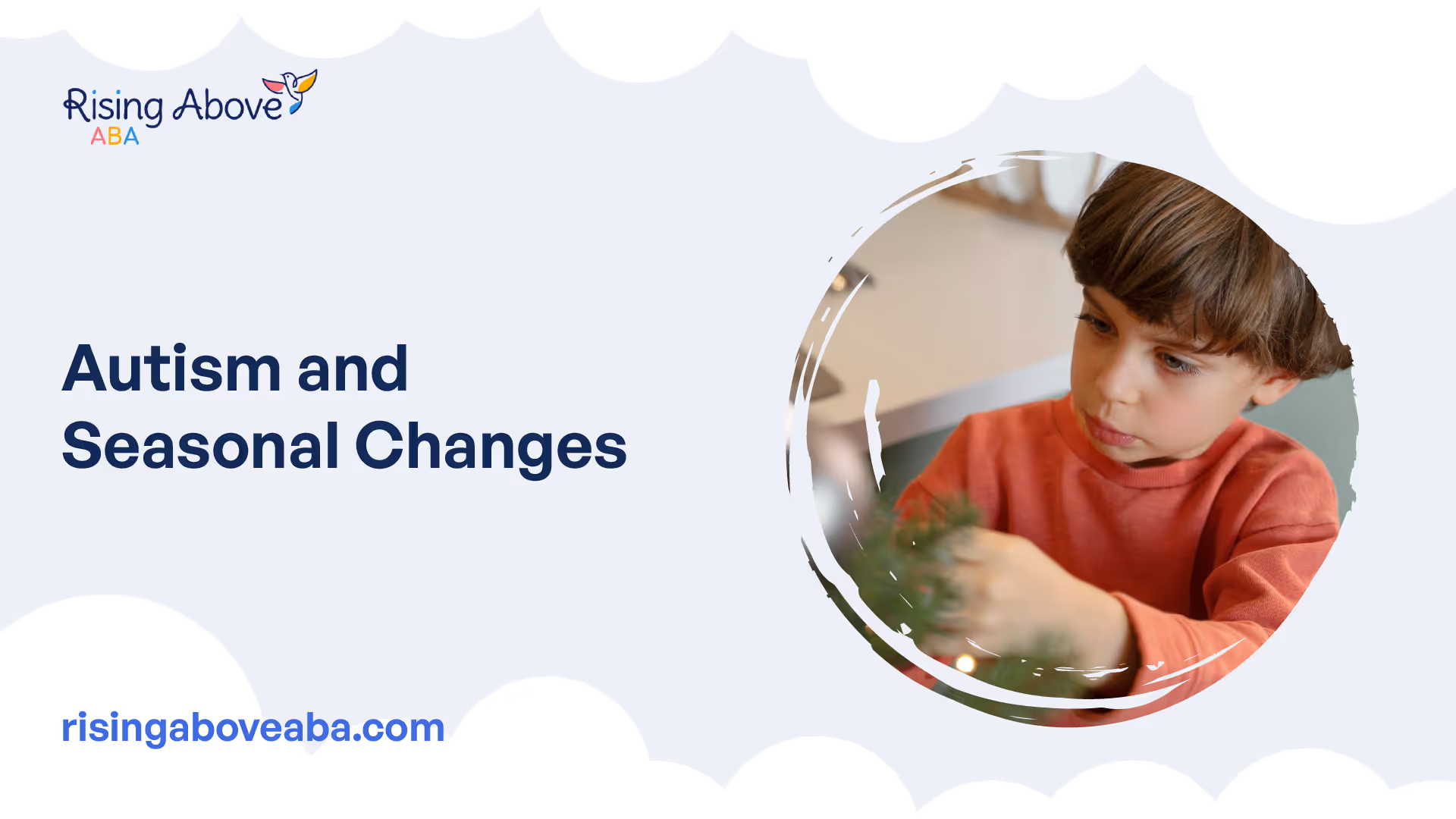Autism and Seasonal Changes
Discover the impact of seasonal changes on autism and effective strategies for navigating through.
.avif)
Impact of Seasonal Changes on Autism
Seasonal changes can have a significant impact on individuals with autism, affecting various aspects of their lives. In this section, we will explore the disruptions in routines and the impact on sleep patterns and behavioral issues that can arise during seasonal transitions.
Disruptions in Routines
Children with autism thrive on predictable routines and structure in their daily lives. Seasonal changes, such as the shift from summer to autumn or winter to spring, can introduce unexpected disruptions to their established routines. These disruptions can lead to increased anxiety, stress, and potential behavioral issues or meltdowns.
The change in daylight hours, for example, can affect the timing and sequencing of activities that individuals with autism rely on for stability. The adjustment to new schedules and routines can be particularly challenging for those on the autism spectrum, potentially causing distress and difficulties in adapting to the changes.

Sleep Patterns and Behavioral Issues
Seasonal changes can also significantly impact the sleep patterns of individuals with autism. The fluctuation in daylight hours and changes in natural light can disrupt the body's internal clock, leading to difficulties in falling asleep and waking up at regular times. These disturbances in sleep patterns can result in difficulties in focusing, learning problems, and behavioral issues.
For individuals with autism, who may already struggle with sleep-related challenges, such as insomnia or difficulties with sleep regulation, seasonal transitions can exacerbate these issues. It is important for caregivers and parents to be aware of these potential disruptions and provide support and strategies to help maintain a consistent sleep routine throughout the changing seasons.
Understanding and addressing the impact of seasonal changes on individuals with autism is crucial for promoting their well-being and minimizing potential challenges. By recognizing the disruptions in routines and the effect on sleep patterns and behavioral issues, caregivers and individuals can implement strategies to navigate these transitions more effectively. In the next section, we will explore strategies for navigating seasonal changes and supporting individuals with autism during these times.
Strategies for Navigating Seasonal Changes
Navigating seasonal changes can be challenging for individuals with autism. However, there are effective strategies that can be employed to help autistic individuals adapt and cope with these transitions. Two key strategies include pre-teaching and adjustments, as well as planning indoor activities.
Pre-teaching and Adjustments
Preparation is key when it comes to helping autistic individuals navigate seasonal changes. Pre-teaching involves providing information about the upcoming changes in a clear and structured manner. This can be done through visual calendars, books, or discussions about different types of weather. By familiarizing them with what to expect, autistic individuals can better understand and process the changes that come with each season.
In addition to pre-teaching, making small adjustments can significantly support autistic individuals during seasonal transitions. This may involve modifying daily routines and schedules to accommodate the changes brought about by the new season. For example, adjusting bedtime routines, meal times, or incorporating sensory breaks can help individuals maintain a sense of stability and reduce anxiety.
Planning Indoor Activities
Seasonal changes often bring about extreme weather conditions that may limit outdoor activities. Planning indoor activities can be a great way to engage autistic individuals during these times. Creating a list of indoor activities, such as arts and crafts, sensory play, or board games, can provide structure and stimulation while ensuring a safe and comfortable environment.
Indoor activities can also serve as an opportunity to explore new interests and encourage social interaction. For example, organizing movie nights, cooking sessions, or virtual meetups with friends or family members can provide enjoyable and meaningful experiences. It's important to consider the individual's preferences and sensory sensitivities when planning these activities to ensure a positive experience.
By implementing pre-teaching and adjustments, as well as planning engaging indoor activities, autistic individuals can navigate seasonal changes with greater ease. These strategies help to prepare them for the transitions and provide a sense of stability and comfort during times of change. Remember, each individual with autism is unique, so it's important to tailor these strategies to their specific needs and preferences. To learn more about the basic needs of people with autism, visit our article on 3 basic needs of people with autism.
Sensory Sensitivities and Seasonal Influences
Autistic individuals often experience sensory sensitivities that can be influenced by seasonal changes. These sensitivities can significantly impact their daily functioning and overall well-being. In this section, we will explore two important aspects of sensory sensitivities related to seasonal influences: color preferences and the impact of lighting.
Color Preferences and Lighting Impact
Seasonal changes can affect the sensory experiences of individuals with autism, including their color preferences and the impact of lighting. Autistic individuals may exhibit changes in their color preferences during different seasons, which can be attributed to their unique sensory processing patterns. For example, some individuals may develop a preference for certain colors during specific seasons, while others may display heightened sensitivity to bright or intense colors.
Lighting conditions also play a crucial role in how individuals with autism perceive and interact with their environment. Changes in natural lighting, such as the transition from longer daylight hours in summer to shorter days in winter, can impact their sensory experiences. Shifts in natural lighting can affect their visual perception, mood, and overall sensory processing. Some individuals may be more sensitive to bright or fluorescent lighting, which can lead to discomfort, sensory overload, and difficulties with concentration and focus.
To support individuals with autism during seasonal changes, it is important to create environments that accommodate their sensory needs. This may involve adjusting the lighting conditions by using softer, diffused lighting or providing options for individuals to control the level of brightness. Creating a sensory-friendly environment can help minimize sensory overload and promote a more comfortable experience for individuals with autism.
Daily Functioning Challenges
Seasonal changes can introduce daily functioning challenges for individuals with autism. Transitioning between seasons may disrupt established routines, which are often crucial for individuals with autism to navigate their daily lives successfully. Changes in weather, temperature, and activities can lead to increased anxiety and difficulty adapting to new schedules and expectations.
Parents and caregivers can support individuals with autism during seasonal transitions by employing strategies such as pre-teaching and making adjustments to routines. Pre-teaching involves providing information and visual aids to prepare individuals for upcoming changes in weather and activities. Visual calendars, social stories, and visual schedules can help individuals with autism understand and anticipate the adjustments that come with seasonal changes. These tools provide a visual representation of the new routines and can assist in reducing anxiety and facilitating a smoother transition.
Additionally, planning indoor activities that align with an individual's interests and sensory preferences can help maintain a sense of stability and engagement during seasonal changes. Engaging in activities that are familiar and enjoyable can provide a sense of predictability and comfort, supporting individuals with autism in coping with the challenges that arise during seasonal transitions.
By recognizing the impact of sensory sensitivities on individuals with autism during seasonal changes, and implementing strategies to address these challenges, we can create a more inclusive and supportive environment for individuals on the autism spectrum. Understanding the unique sensory experiences and providing necessary accommodations can help individuals with autism thrive during seasonal transitions.
Seasonal Birth Peaks and ASD Risk
The incidence of Autism Spectrum Disorder (ASD) has been found to show a correlation with birth peaks during specific months or seasons, suggesting a potential relationship between seasonal changes and the risk of ASD. Several studies have explored this connection and shed light on the influence of conception months on the prevalence of ASD.
Correlation Studies
Research has shown that there is a correlation between the occurrence of ASD and birth peaks during certain months or seasons within a year. For example, a study conducted in Finland and Sweden found a modest increase in the risk of ASD for children born in the fall, while a modest decrease in risk was observed for children born in the spring. These findings suggest that seasonal factors may play a role in the development of ASD.
Influence of Conception Months
The timing of conception has also been found to be associated with the risk of ASD. Children conceived during winter months are more likely to have autism and other developmental conditions compared to those conceived in summer. In fact, babies conceived during colder months account for 11.4 percent of cases of autism, intellectual disability, and learning difficulties. The prevalence of autism is slightly higher in babies conceived during winter months, with approximately 1 percent of those conceived in colder months being diagnosed with ASD, compared to 0.9 percent of those conceived in warmer months.
It is worth noting that these correlations do not imply causation, and the exact mechanisms underlying the relationship between conception months, seasonal changes, and ASD risk are not fully understood. However, these findings highlight the potential impact of seasonal factors on the development of ASD and warrant further research.
Understanding the influence of seasonal birth peaks and conception months on ASD risk can contribute to a better understanding of the complex nature of autism. It is important for researchers and healthcare professionals to continue investigating these associations to gain a more comprehensive understanding of the environmental factors that may contribute to the development of ASD.
Histamine Levels and Seasonal Behavior
When exploring the impact of seasonal changes on individuals with autism, understanding the role of histamine levels is crucial. Research has shown a connection between histamine and behavioral changes in children on the autism spectrum, particularly during the spring season. Histamine, a neurotransmitter that acts on nerve cells and the brain, influences various functions such as learning, attention, mood, and sleep.
Connection to Behavioral Changes
Children with autism often have higher than normal histamine levels compared to neurotypical children, even if they do not exhibit typical allergic responses like sneezing or itchy eyes. Elevated histamine levels, specifically H3, can contribute to an increase in hyperactivity, impulsivity, anxiety, and compulsions. Conversely, low histamine levels may lead to symptoms such as fatigue, irritability, and depression.
Parents frequently observe an escalation or sudden onset of behavioral changes during the spring or fall seasons, which can include restlessness, irritability, violent behavior, and rage. These behavioral changes may be linked to fluctuations in histamine levels, affecting the central nervous system.
Role of Antihistamines
Antihistamines, commonly used to treat allergies, can also play a role in managing behavioral changes associated with histamine levels. These medications have been utilized to address anxiety, indicating a potential connection between histamine and mental health conditions. Some parents have reported improvements in their child's behavior after administering antihistamines for a few days, suggesting that histamine regulation may contribute to behavioral changes.
It is essential to consult with a healthcare professional before considering the use of antihistamines for behavioral changes related to autism and seasonal influences. They can provide guidance on appropriate dosage and monitor any potential side effects. Understanding the complex relationship between histamine levels and behavioral changes can help parents and caregivers navigate the challenges associated with seasonal transitions in individuals with autism. For more information on autism-related topics, visit our articles on parental advocacy in autism education and parenting stress in mothers of autistic children.
Vitamin D and ASD
Vitamin D, often referred to as the "sunshine vitamin," plays an important role in various aspects of health. In recent years, researchers have explored the connection between vitamin D levels and Autism Spectrum Disorder (ASD). In this section, we will delve into the relationship between vitamin D and ASD, including lower levels in individuals with ASD and the potential risk associated with maternal deficiency.
Lower Levels in ASD
Multiple studies have indicated that children and adolescents with ASD tend to have lower vitamin D levels compared to control groups. In fact, research has consistently shown that children with ASD have significantly lower vitamin D levels compared to typically developing children, with vitamin D deficiency strongly correlated with the severity of ASD symptoms [7].
The reasons behind the lower vitamin D levels in individuals with ASD are not yet fully understood. However, it is believed that factors such as limited sun exposure, dietary restrictions, and altered metabolism may contribute to these lower levels. Further research is needed to gain a comprehensive understanding of this relationship.
Maternal Deficiency and Risk
Maternal vitamin D deficiency during pregnancy has also been associated with an increased risk of ASD-like symptoms in children. Studies have found that maternal vitamin D deficiency during pregnancy is linked to an increased risk of ASD development in offspring, potentially impacting fetal brain development and the nervous system.
It is important to note that while research suggests a potential link between maternal vitamin D deficiency and ASD risk, it does not imply causation. The precise mechanisms behind this association are still being investigated, and more research is needed to establish a clear understanding of the relationship.
To ensure optimal vitamin D levels, it is advisable for individuals with ASD and pregnant women to consult with their healthcare providers. They can assess their vitamin D status and provide appropriate recommendations for supplementation or sun exposure, taking into account individual needs and circumstances.
Understanding the role of vitamin D in ASD is an ongoing area of research. While lower vitamin D levels have been observed in individuals with ASD and maternal deficiency has been associated with increased ASD risk, further studies are required to fully elucidate the complex relationship between vitamin D and ASD.
References

Compassion. Communication. Positivity. Professionalism
Give us a call at 888.572.7473 or reach out to our team online to get started—we're looking forward to partnering with your family.
Latest articles
.avif)





Reach Out to Rising Above ABA

Most commercial insurance accepted
Contact us for any questions regarding coverage or plans – we’ll be happy to provide you with the clear guidance as to your best options.


